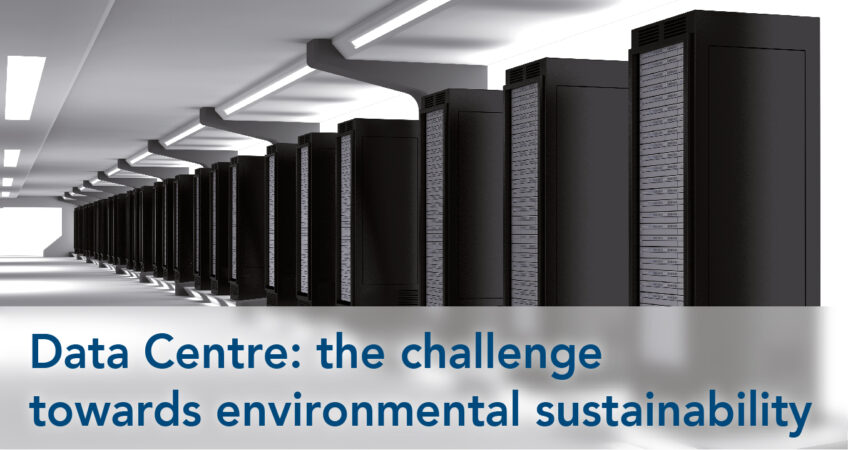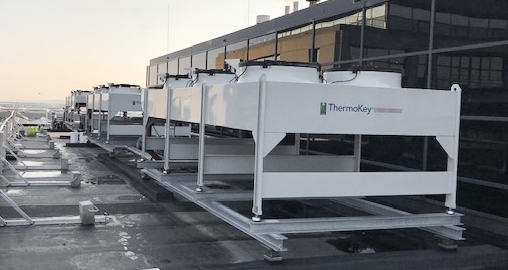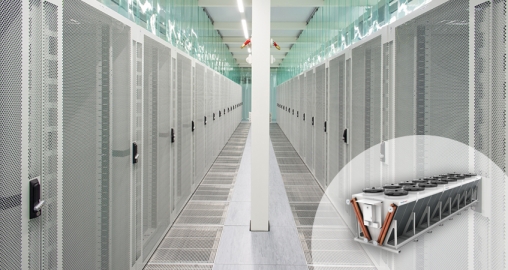CONTEXT
In 2020, every person on earth generated 1.7 megabytes of information per second. By 2025, the amount of data generated each day could reach 463 exabytes1. To store all this data it is necessary to extend the archiving space, thus expand and build new data centres. This need led the data centre market to be one of the few that did not stop during the period of the Covid-192 pandemic but rather to record a significant growth.
The manufacturing market of these infrastructures can be considered the market with the best performance at an international level, overtaking this year the transport (road, rail and port), industrial, manufacturing and distribution market.
The spending on global data centre infrastructures will reach $ 200 billions in 2021, with a 6% increase over last year’s spending3.

ENVIRONMENTAL EMERGENCY
The problems arising from the increase of data centre are numerous, and already a decade ago, newspapers and analysts began to report the energy consumption and environmental impact associated with this market.
An important push towards greener strategies was given by the climate change plan that the European Union came up with last July. To achieve the aim of becoming carbon neutral by 2050, the data centre market is seeing a revision of the greenhouse gas regulations that are used in the cooling operation. The EU aim is to gradually reduce the use of “fluorinated gases” refrigerants in favor of more climate-friendly alternatives.

To better understand the impact of data centre on the climate, it is possible to evaluate a series of standard KPIs in agreement with the Climate Neutral Data Center Pact and the UN 2030 SDGs. In particular, the following metrics should be considered:
• PUE (Power Usage Effectiveness) is a ratio used to measure the energy efficiency of a data centre. It is the ratio between the total power consumed by the data centre and by the IT equipment one. A PUE score of 1.0 would indicate 100% efficiency, while a score of 2.5 or higher would indicate very low efficiency.
• The Water Usage Effectiveness (WUE) is a ratio that measures the amount of water used by a data centre for cooling, temperature, humidity control and electricity generation.
ENERGY CONSUMPTION
In 2018, the energy consumption of the data centres of the European Union states was 76.8 TWh, equivalent to 2.7% of the total electricity demand. If the growth continues at its current pace, consumption will rise to 98.5 TWh in 2030, or 3.2% of demand2.
Most of the data centre energy is used for their cooling as they are large heat producers. About 30% of the consumed energy is indeed destined for cooling systems, which use water to maintain a constant temperature of 20-22 ° C. For this reason, most data centre are built in cold countries which guarantee lower PUEs than data centres located in warmer places.

WATER CONSUMPTION
A medium-sized data center (15 MW like the ones we have in Italy) can consume as much water as three small hospitals or the equivalent of two 18-hole golf courses
A 2021 study estimates that US data centres consume 1.7 billion liters of water per day, that is, 0.001% of that country’s daily consumption.
In the European Green Deal, the “Climate Neutral Data Center Pact” expects that by 2025, all new Data Centres above 50 kW must have a minimum PUE of 1.4. While the already operative Data Centres will have to reach the same value by 20304.
In 2025, the aim is also to supply 70% of renewable energy sources and reach 100% by 2030.
DATA CENTRES AS AN OPPORTUNITY
The data centre market, if approached from a green perspective, can be an exceptional opportunity for some companies but especially for some countries that are particularly suitable for hosting these plants.
In Norway, the government saw the rise of data centres as an opportunity for growth and the creation of new jobs. Norway is an ideal place for the construction of new efficient and sustainable data centers thanks to its cold climate, 98% electricity is generated from renewable sources and its prices are among the most competitive in Europe.
The problem of generated heat by data centres was also taken as a challenge by Norway, which with the Green Mountain colocation company collaborated with Norwegian Lobster Farm to reuse waste heat from data centres in the first world’s lobster farm5.
THERMOKEY'S EXPERIENCE IN THE DATA CENTRE MARKET
ThermoKey, thanks to its experience in the realization of cooling systems for data centre, offers a wide range of products to find the best solution for every need.
The topic of removing the hot air generated by IT equipment can be easily dealt with by using an air duct, but generally a heat exchanger is used to transfer heat from one fluid to another (for example from air to water).
Below is a diagram of the methods that ThermoKey applies for the removal of hot air used to cool computer rooms and Data Centre.

Moreover, thanks to its experience, ThermoKey understood the great importance of product customization to meet the different needs due to the installation place of the cooling plants.
Some examples here below highlight which can be the specific needs of plants located in different environments:
- special materials and treatments for environments with particular features (eg coastal environment);
- solutions adapted to the national reference norms;
- electrical specifications required in the different plants (level of harmonic distortion, maximum short-circuit current, etc.);
- customization with electrical components brands which are a mandatory specification for all elements of the plant;
- communication protocols dedicated to the plant / project specification.
Making cooling systems more and more environmentally friendly is essential for Thermokey, which constantly invests in researching new technologies that encourage the reuse of heat generated by data centers. Working to achieve the climate and environmental sustainability objectives imposed by the EU, must be an opportunity for development and continuous improvement, which are our goal to have a concrete and positive impact for the sustainable future of the planet.
SOURCES:
1 https://www.monitorimmobiliare.it/jll-data-center-e-sostenibilita-report_20216301030
2 https://d110erj175o600.cloudfront.net/wp-content/uploads/2020/11/FINALSTUDYEnglishKK-03-20-210-EN-N13072020pdf.pdf
3 https://www.01net.it/data-center-green-schneider-electric/
4 https://www.climateneutraldatacentre.net/
5 https://www.capacitymedia.com/articles/3829326/norway-updates-sustainability-strategy-for-data-centre-industry
-
Cooling solution for the supercomputer ECMWF at Bologna Tecnopolo
-
ThermoKey has been chosen for the replacement of 3 existing dry coolers of another brand for the cooling of a Data Center
-
Data Center, Europe - 18 Dry Coolers V-Type adiabatic and self-cleaning - Cooling down an important Data Center
-
Server in Basel (Switzerland) - Cooling down 4.5 MW Total Capacity in a small footprint area




